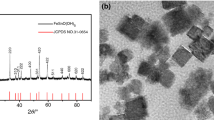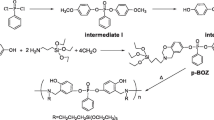Abstract
Bismuth oxychloride nanosheet modified with silane coupling agent (KH570-BiOCl) was prepared by a facile liquid-phase method and used as a green inorganic flame retardant to replace Sb2O3, a conventional flame retardant of flexible poly (vinyl chloride), PVC in short. The as-prepared nanosheet was characterized by X-ray diffraction, scanning electron microscopy and Fourier transform infrared spectrometry. Its effect on the flame-retardant performance of PVC was investigated by cone calorimetry test (CCT) in association with thermogravimetric analysis (TGA) as well as condensed-phase and gas-phase analyses by Raman spectroscopy and thermogravimetric–infrared spectrometry, respectively. TGA and CCT results indicated that, as a potential flame retardant of PVC, the as-prepared KH570-BiOCl nanosheet with a thickness of about 30–40 nm had good charring ability and could effectively improve the flame retardancy of PVC. Particularly, the PVC-matrix composite with 3% (mass fraction) of KH570-BiOCl nanosheet exhibited 18.65% of char residue as well as significantly reduced the peak heat release rate (45.3%), peak smoke production rate (55.3%) and total smoke production (31.4%). This is because the BiOCl nanosheet could act as a physical barrier to prevent the heat transfer as well as the release and diffusion of the decomposed products of PVC matrix, while it also could catalyze and promote the formation of char layer in the manner similar to that of gaseous phase of Sb2O3. Thus, the KH570-BiOCl nanosheet showed great potential to replace Sb2O3 and provided the promising manner to develop an environmental friendly PVC composite.










Similar content being viewed by others
References
Qin Z, Li D, Li Q, Yang R (2016) Effect of nano-aluminum hydroxide on mechanical properties, flame retardancy and combustion behavior of intumescent flame retarded polypropylene. Mater Des 89:988–995
Zhang Z, Wu W, Zhang M, Qu J, Shi L (2017) Hydrothermal synthesis of 4ZnO·B2O3·H2O/RGO hybrid material and its flame retardant behavior in flexible PVC and magnesium hydroxide composites. Appl Surf Sci 425:896–904
Gholamian F, Nabiyouni G, Ghanbari D, Jalajerdi R, Aminifazl A (2013) Synergistic effect between Sb2O3 nanostructure and brominated compound on the flame retardant properties of the polymeric matrixes. High Temp Mater Process 32:564–571
Pan Y, Castillo-Rodríguez M, Wang D (2018) Mesoporous metal oxide/pyrophosphate hybrid originated from reutilization of water treatment resin as a novel fire hazard suppressant. Mater Chem Phys 203:49–57
Carosio F, Maddalena L, Gomez J, Saracco G, Fina A (2018) Graphene oxide exoskeleton to produce self-extinguishing, nonignitable, and flame resistant flexible foams: a mechanically tough alternative to inorganic aerogels. Adv Mater Interfaces 5:1801288
Lorenza Maddalena FC, Gomez J, Guido Saracco AF (2018) Layer-by-layer assembly of efficient flame retardant coatings based on high aspect ratio graphene oxide and chitosan capable of preventing ignition of PU foam. Polym Degrad Stabil 152:1–9
Zhou K, Liu J, Shi Y (2015) MoS2 nanolayers grown on carbon nanotubes: an advanced reinforcement for epoxy composites. ACS Appl Mater Interfaces 7:6070–6081
Zhang Q, Li Z, Li X, Yu L, Zhang Z, Wu Z (2019) Zinc ferrite nanoparticle decorated boron nitride nanosheet: preparation, magnetic field arrangement, and flame retardancy. Chem Eng J 356:680–692
Lazar S, Carosio F, Davesne A-L, Jimenez M, Bourbigot S, Grunlan J (2018) Extreme heat shielding of clay/chitosan nanobrick wall on flexible foam. ACS Appl Mater Interfaces 10:31686–31696
Hou Y, Qiu S, Hu Y, Kundu C, Zhou G, Hu W (2018) Construction of bimetallic ZIF-derived Co–Ni LDHs on the surfaces of GO or CNTs with a recyclable method: toward reduced toxicity of gaseous thermal decomposition products of unsaturated polyester Resin. ACS Appl Mater Interfaces 10:18359–18371
Yue X, Li C, Ni Y, Xu Y, Wang J (2019) Flame retardant nanocomposites based on 2D layered nanomaterials: a review. J Mater Sci 54:13070–13105. https://doi.org/10.1007/s10853-019-03841-w
Han Y, Wu Y, Shen M, Huang X, Zhu J, Zhang X (2013) Preparation and properties of polystyrene nanocomposites with graphite oxide and graphene as flame retardants. J Mater Sci 48:4214–4222. https://doi.org/10.1007/s10853-013-7234-8
Cai W, Zhan J, Feng X (2017) Facile construction of flame-retardant-wrapped molybdenum disulfide nanosheets for properties enhancement of thermoplastic polyurethane. Ind Eng Chem Res 56:7229–7238
Jiang J, Zhao K, Xiao X, Zhang L (2012) Preparation of zinc hydroxystannate-decorated graphene oxide nanohybrids and their synergistic reinforcement on reducing fire hazards of flexible poly(vinyl chloride). J Am Chem Soc 134:4473–4476
Qi Y, Wu W, Han L (2015) Using TG-FTIR and XPS to understand thermal degradation and flame-retardant mechanism of flexible poly(vinyl chloride) filled with metallic ferrites. J Therm Anal Calorim 123:1263–1271
Jiang S, Gui Z, Shi Y (2014) Bismuth subcarbonate nanoplates for thermal stability, fire retardancy and smoke suppression applications in polymers: a new strategy. Polym Degrad Stabil 107:1–9
Gao T, Chen L, Li Z, Yu L, Wu Z, Zhang Z (2016) Preparation of zinc hydroxystannate-decorated graphene oxide nanohybrids and their synergistic reinforcement on reducing fire hazards of flexible poly (vinyl chloride). Nanoscale Res Lett 11:192–202
Hujo W, Gaus M, Schultze M (2011) Effect of nitrogen adsorption on the mid-infrared spectrum of water clusters. J Phys Chem A 115:6218–6225
Song Y, Jiang H, Shi X, Chen J, Wu Y, Wei W (2018) Detection of lead using a sensitive anodic stripping voltammetric method based on composite mesoporous silica/bismuth oxychloride modified electrode. ChemistrySelect 3:2423–2429
Lu Y, Li X, Wu C, Xu S (2018) Comparison between polyether titanate and commercial coupling agents on the properties of calcium sulfate whisker/poly(vinyl chloride) composites. J Alloy Compd 750:197–205
Lv Y, Deng Q, Row KH, Zhu T (2018) Silane coupling agents modified silica and graphene oxide materials for determination of sulfamerazine and sulfameter in milk by HPLC. Food Anal Methods 12:687–696
Ma M, Yang Y, Liao D (2019) Synthesis, characterization and catalytic performance of core-shell structure magnetic Fe3O4/P(GMA-EGDMA)-NH2/HPG-COOH-Pd catalyst. Appl Organomet Chem 33:4708–4718
Gao B, Chakraborty AK, Yang JM, Lee WI (2010) Visible-light photocatalytic activity of BiOCl/Bi3O4Cl nanocomposites. Bull Korean Chem Soc 31:1941–1944
Zhou Y, Yu J, Wang X, Wang Y, Zhu J, Hu Z (2015) Preparation of KH570-SiO2 and their modification on the MF/PVA composite membrane. Fiber Polym 16:1772–1780
Yang W, Tawiah B, Yu C (2018) Manufacturing, mechanical and flame retardant properties of poly(lactic acid) biocomposites based on calcium magnesium phytate and carbon nanotubes. Compos Pt A: Appl Sci Manuf 110:227–236
Chen Y, Zhang S, Han X (2018) Catalytic dechlorination and charring reaction of polyvinyl chloride by CuAl layered double hydroxide. Energy Fuels 32:2407–2413
Cheng L, Wu W, Meng W (2018) Application of metallic phytates to poly(vinyl chloride) as efficient biobased phosphorous flame retardants. J Appl Polym Sci 135:46601–46611
Zheng Z, Liu Y, Dai B, Meng C, Guo Z (2019) Fabrication of cellulose-based halogen-free flame retardant and its synergistic effect with expandable graphite in polypropylene. Carbohydr Polym 213:257–265
Pan Y, Wang X, Li X, Wang D (2017) A facile approach towards large-scale synthesis of hierarchically nanoporous SnO2 @Fe2O3 0D/1D hybrid and its effect on flammability, thermal stability and mechanical property of flexible poly(vinyl chloride). Compos Pt B-Eng 110:46–55
Sang B, Li Z, Li X, Yu L, Zhang Z (2016) Graphene-based flame retardants: a review. J Mater Sci 51:8271–8295. https://doi.org/10.1007/s10853-016-0124-0
Brehme S, Köppl T, Schartel B, Altstädt V (2014) Competition in aluminium phosphinate-based halogen-free flame retardancy of poly(butylene terephthalate) and its glass-fibre composites. e-Polymers 14:193–208
Tang S, Wachtendorf V, Klack P, Qian L, Dong Y, Schartel B (2017) Enhanced flame-retardant effect of a montmorillonite/phosphaphenanthrene compound in an epoxy thermoset. RSC Adv 7:720–728
Feng J, Hao J, Du J, Yang R (2012) Using TGA/FTIR TGA/MS and cone calorimetry to understand thermal degradation and flame retardancy mechanism of polycarbonate filled with solid bisphenol A bis(diphenyl phosphate) and montmorillonite. Polym Degrad Stabil 97:605–614
Huang G, Song P, Liu L (2016) Fabrication of multifunctional graphene decorated with bromine and nano-Sb2O3 towards high-performance polymer nanocomposites. Carbon 98:689–701
Qiu S, Xing W, Feng X (2017) Self-standing cuprous oxide nanoparticles on silica@ polyphosphazene nanospheres: 3D nanostructure for enhancing the flame retardancy and toxic effluents elimination of epoxy resins via synergistic catalytic effect. Chem Eng J 309:802–814
Meng W, Wu W, Zhang W (2019) Bio-based Mg(OH)2@M-Phyt: improving the flame-retardant and mechanical properties of flexible poly(vinyl chloride). Polym Int. https://doi.org/10.1002/pi.5885
Yuan Y, Ma C, Shi Y, Song L, Hu Y, Hu W (2018) Highly-efficient reinforcement and flame retardancy of rigid polyurethane foam with phosphorus-containing additive and nitrogen-containing compound. Mater Chem Phys 211:42–53
Zhang H, Zhang S, Stewart P (2016) Thermal stability and thermal aging of poly(vinyl chloride)/MgAl layered double hydroxides composites. Chin J Polym Sci 34:542–551
Zhang J, Chen T, Wu J, Wu J (2015) TG-MS analysis and kinetic study for thermal decomposition of six representative components of municipal solid waste under steam atmosphere. Waste Manag 43:52–61
Zhu H, Wang W, Liu T (2011) Effects of copper-containing layered double hydroxide on thermal and smoke behavior of poly(vinyl chloride). J Appl Polym Sci 122:273–281
Zhou H, Meng A, Long Y, Li Q, Zhang Y (2014) Interactions of municipal solid waste components during pyrolysis: a TG-FTIR study. J Anal Appl Pyrolysis 108:19–25
Lu T, Liu S, Jiang M (2014) Effects of modifications of bamboo cellulose fibers on the improved mechanical properties of cellulose reinforced poly(lactic acid) composites. Compos Pt B-Eng 62:191–197
Acknowledgements
The authors appreciate the financial support from the Ministry of Science and Technology of China (Project of “973” Plan; Grant No. 2015CB654703) and Henan Provincial Department of Education (Key Project of Science and Technology Research; Grant No. 19A430009).
Author information
Authors and Affiliations
Corresponding authors
Ethics declarations
Conflict of interest
The authors declare no competing financial interest.
Additional information
Publisher's Note
Springer Nature remains neutral with regard to jurisdictional claims in published maps and institutional affiliations.
Electronic supplementary material
Below is the link to the electronic supplementary material.
Rights and permissions
About this article
Cite this article
Shi, H., Zhao, X., Li, Z. et al. Bismuth oxychloride nanosheets for improvement of flexible poly (vinyl chloride) flame retardancy. J Mater Sci 55, 631–643 (2020). https://doi.org/10.1007/s10853-019-04048-9
Received:
Accepted:
Published:
Issue Date:
DOI: https://doi.org/10.1007/s10853-019-04048-9




